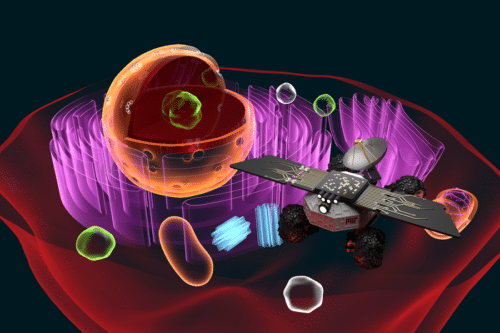Researchers at the MIT Media Lab have developed a cell rover with a miniaturized magnetostrictive antenna that can wirelessly operate inside a living cell

It is essential to monitor physical changes of the cell, as one cell can affect a whole organism, but typical bioelectric interfaces are millimeters or even centimeters in size are highly invasive, and fail to provide the resolution needed to interact with single cells wirelessly and conventional antennas have to increase frequency to reduce the size of the antenna, high frequencies can cause damage to living tissue. Hence, MIT researchers designed a cell rover that consists of an intracellular antenna that is compatible with biological systems and can efficiently work wirelessly inside a living cell. The antenna developed by researchers converts electromagnetic waves into acoustic waves with wavelengths five orders of magnitude smaller. This cell rover could provide real-time monitoring of the development or division of a cell, analyzing different chemicals and biomolecules such as enzymes, or physical changes such as cell pressure in vivo instead of destroying cells to examine their cytoplasm as is typically done
Due to technological advancement and scaling of nanoelectronic devices such as transistors and switches “representing five decades of tremendous advancements in the field of information technology,” Sarkar says, assistant professor and AT&T Career Development Chair at the MIT Media Lab and head of the Nano-Cybernetic Biotrek Lab, the Cell Rover, with its mini antenna, could carry out functions ranging from intracellular computing and information processing for autonomous exploration and modulation of the cell. The research shows that multiple Cell Rovers can work together, within a single cell, to communicate among themselves and outside of the cells.
“The Cell Rover is an innovative concept as it can embed sensing, communication, and information technology inside a living cell,” says Anantha P. Chandrakasan, dean of the MIT School of Engineering and the Vannevar Bush Professor of Electrical Engineering and Computer Science. “This opens up unprecedented opportunities for extremely precise diagnostics, therapeutics, and drug discovery, as well as creating a new direction at the intersection between biology and electronic devices.”
The conversion of electromagnetic waves into acoustic waves is accomplished by fabricating the miniature antennas using material that is referred to as magnetostrictive. When a magnetic field is applied to the antenna, powering and activating it, magnetic domains within the magnetostrictive material align to the field, creating strain in the material, the way metal bits woven into a piece of cloth could react to a strong magnet, causing the cloth to contort. Materials such as polymers that undergo a change in mass or stress in response to chemical or biomolecular changes could provide insights without the destruction of the cell. When an alternating magnetic field is applied to the antenna, the varying strain and stress (pressure) produced in the material is what create the acoustic waves in the antenna. This antenna configuration could be used to explore the fundamentals of biology as natural processes occur, Sarkar says.
This cell rover with above mentioned capabilities could be valuable in cancer and neurodegenerative disease research.
Click here for the Published Research Paper








